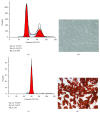Inflammatory Microenvironment and Adipogenic Differentiation in Obesity: The Inhibitory Effect of Theobromine in a Model of Human Obesity In Vitro
- PMID: 30804705
- PMCID: PMC6360562
- DOI: 10.1155/2019/1515621
Inflammatory Microenvironment and Adipogenic Differentiation in Obesity: The Inhibitory Effect of Theobromine in a Model of Human Obesity In Vitro
Abstract
Objective: Obesity is considered a clinic condition characterized by a state of chronic low-grade inflammation. The role of macrophages and adipocytokines in adipose tissue inflammation is in growing investigation. The physiopathological mechanisms involved in inflammatory state in obesity are not fully understood though the adipocytokines seem to characterize the biochemical link between obesity and inflammation. The aim of this work is to analyze the effect of theobromine, a methylxanthine present in the cocoa, on adipogenesis and on proinflammatory cytokines evaluated in a model of fat tissue inflammation in vitro.
Methods: In order to mimic in vitro this inflammatory condition, we investigated the interactions between human-like macrophages U937 and human adipocyte cell lines SGBS. The effect of theobromine on in vitro cell growth, cell cycle, adipogenesis, and cytokines release in the supernatants has been evaluated.
Results: Theobromine significantly inhibits the differentiation of preadipocytes in mature adipocytes and reduces the levels of proinflammatory cytokines as MCP-1 and IL-1β in the supernatants obtained by the mature adipocytes and macrophages interaction.
Conclusion: Theobromine reduces adipogenesis and proinflammatory cytokines; these data suggest its potential therapeutic effect for treating obesity by control of macrophages infiltration in adipose tissue and inflammation.
Figures






Similar articles
-
1,25-Dihydroxyvitamin D3 inhibits the cytokine-induced secretion of MCP-1 and reduces monocyte recruitment by human preadipocytes.Int J Obes (Lond). 2013 Mar;37(3):357-65. doi: 10.1038/ijo.2012.53. Epub 2012 Apr 17. Int J Obes (Lond). 2013. PMID: 22508334 Free PMC article.
-
Highly hydroxylated fullerene localizes at the cytoskeleton and inhibits oxidative stress in adipocytes and a subcutaneous adipose-tissue equivalent.Free Radic Biol Med. 2011 Oct 1;51(7):1376-89. doi: 10.1016/j.freeradbiomed.2011.05.026. Epub 2011 May 27. Free Radic Biol Med. 2011. PMID: 21684329
-
Macrophage-secreted factors impair human adipogenesis: involvement of proinflammatory state in preadipocytes.Endocrinology. 2007 Feb;148(2):868-77. doi: 10.1210/en.2006-0687. Epub 2006 Nov 2. Endocrinology. 2007. PMID: 17082259
-
Adipose tissue inflammation: novel insight into the role of macrophages and lymphocytes.Curr Opin Clin Nutr Metab Care. 2010 Jul;13(4):366-70. doi: 10.1097/MCO.0b013e32833aab7f. Curr Opin Clin Nutr Metab Care. 2010. PMID: 20473150 Review.
-
The Therapeutic Potential of Theobromine in Obesity: A Comprehensive Review.Nutr Rev. 2025 May 1;83(5):859-868. doi: 10.1093/nutrit/nuae122. Nutr Rev. 2025. PMID: 39271172 Free PMC article. Review.
Cited by
-
Lupenone-Rich Fraction Derived from Cissus quadrangularis L. Suppresses Lipid Accumulation in 3T3-L1 Adipocytes.Life (Basel). 2023 Aug 11;13(8):1724. doi: 10.3390/life13081724. Life (Basel). 2023. PMID: 37629581 Free PMC article.
-
Experimental and Theoretical Study on Theobromine Solubility Enhancement in Binary Aqueous Solutions and Ternary Designed Solvents.Pharmaceutics. 2021 Jul 22;13(8):1118. doi: 10.3390/pharmaceutics13081118. Pharmaceutics. 2021. PMID: 34452079 Free PMC article.
-
Cocoa colonic phenolic metabolites are related to HDL-cholesterol raising effects and methylxanthine metabolites and insoluble dietary fibre to anti-inflammatory and hypoglycemic effects in humans.PeerJ. 2020 Sep 17;8:e9953. doi: 10.7717/peerj.9953. eCollection 2020. PeerJ. 2020. PMID: 32995094 Free PMC article.
-
The Effect of Early Rounds of ex vivo Expansion and Cryopreservation on the Adipogenic Differentiation Capacity of Adipose-Derived Stromal/Stem Cells.Sci Rep. 2019 Nov 4;9(1):15943. doi: 10.1038/s41598-019-52086-9. Sci Rep. 2019. PMID: 31685852 Free PMC article.
-
The Other Side of the Perfect Cup: Coffee-Derived Non-Polyphenols and Their Roles in Mitigating Factors Affecting the Pathogenesis of Type 2 Diabetes.Int J Mol Sci. 2024 Aug 17;25(16):8966. doi: 10.3390/ijms25168966. Int J Mol Sci. 2024. PMID: 39201652 Free PMC article. Review.
References
MeSH terms
Substances
LinkOut - more resources
Full Text Sources
Medical
Miscellaneous

